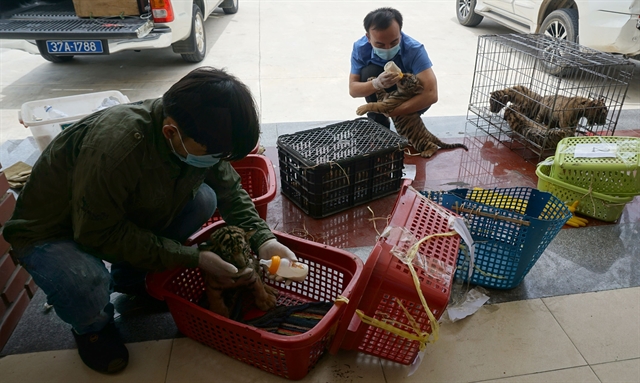On February 27, 2025, PanNature conducted an evaluation of the…

Stricter law enforcement needed to protect tigers
Experts proposed intensifying law enforcement, stepping up inter-sectoral coordination, and closely monitoring captivity facilities to effectively manage the captivity of tigers at a recent seminar held by the People and Nature Reconciliation (PanNature).

The event was organised on Tuesday to review the captivity, trading, rescue, and conservation of tigers in Vi?t Nam after the recent seizure of 17 tigers in central Ngh? An Province.
The tigers were found being raised illegally in the basements of two families in the province on August 4.
Deputy Director of Vietnam CITES Management Authority V??ng Ti?n M?nh said that Ngh? An has been considered a hotspot for illegal wildlife captivity for years, especially in Yên Thành, Di?n Châu and Qu?nh L?u districts. The smuggling of wild animals, especially tigers, is increasingly complicated.
“Authorised agencies of Vi?t Nam have over the past ten years discovered many cases of illegally captivity and trading of tigers with hotspots found chiefly in the central region,” he said.
Vi?t Nam currently has more than 300 tigers legally kept in captivity in farms, facilities and households. However, the actual number of tigers being kept in captivity in the country may be much higher, including those raised illegally.
Numerous studies have shown that tiger breeding facilities are intimately involved in smuggling networks. The United Nations Office on Drugs and Crime (UNODC)’s Wildlife Crime Report 2020 and the Wildlife Trade Monitoring Network (TRAFFIC) Research Report 2019 also showed that the risk of captive tigers entering the illegal market is real.
The TRAFFIC report in 2019 revealed that 58 per cent of tigers seized in Thailand and 30 per cent of tigers seized in Vi?t Nam during 2000-2018 were sourced from captivity facilities.
As part of efforts to better preserve tigers, the Convention on International Trade in Endangered Species or Wild Fauna and Flora (CITES) bans the breeding of tigers for trading purposes from 2007. However, many farms across the globe, particularly in Asia, including Vi?t Nam, still violate the ban to get illegal profits.
The population of tigers worldwide has declined by 93 per cent in the last century and it is estimated that only less than 4,000 remain in the wild, making the tiger one of the world’s most endangered species.
According to the World Wild Fund (WWF) in Vi?t Nam, the loss of tigers would lead to a loss in terms of ecology, culture and science. The conservation of tigers would also help to protect their habitat in nature, particularly forests – that is the dual goal of wildlife conservation.
Director of the Education for Nature Vietnam (ENV) Bùi Th? Hà stated that Vi?t Nam has strict sentences for tiger-related crimes, especially since the Penal Code came into effect.
However, the handling of violators remains limited although hundreds of tigers are being kept at basements in Ngh? An Province and violations relating to tigers are still common, according to Hà.
She suggested the country invest more time and resources in dealing with leaders of tiger smuggling rings, while stressing the importance of news agencies and press outlets to disseminate relevant laws.
Participants suggested to have stricter measures to punish heads of illegal wildlife trading and captivity rings
Source: Vietnamnews



